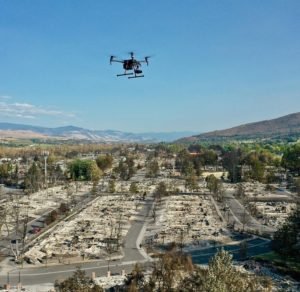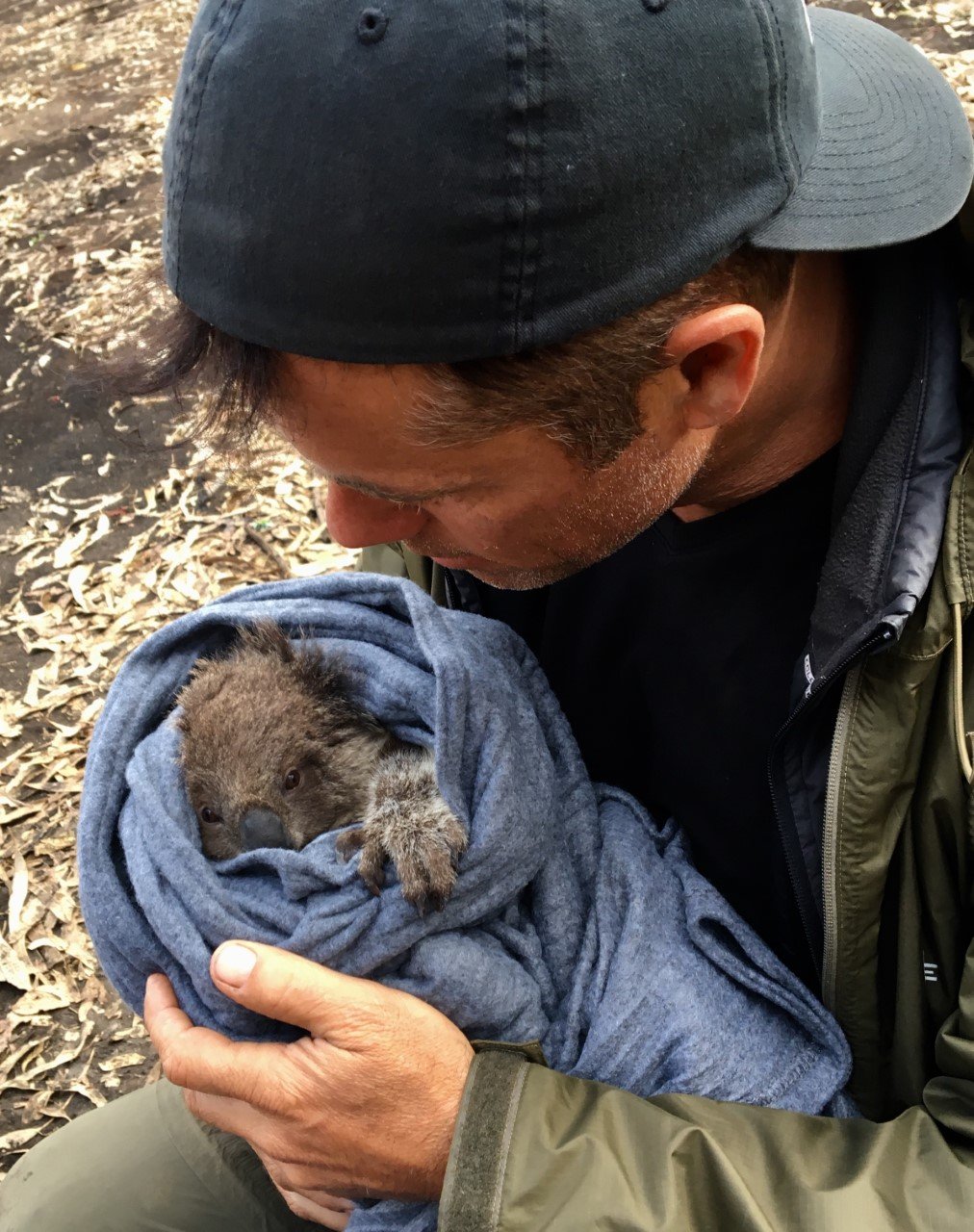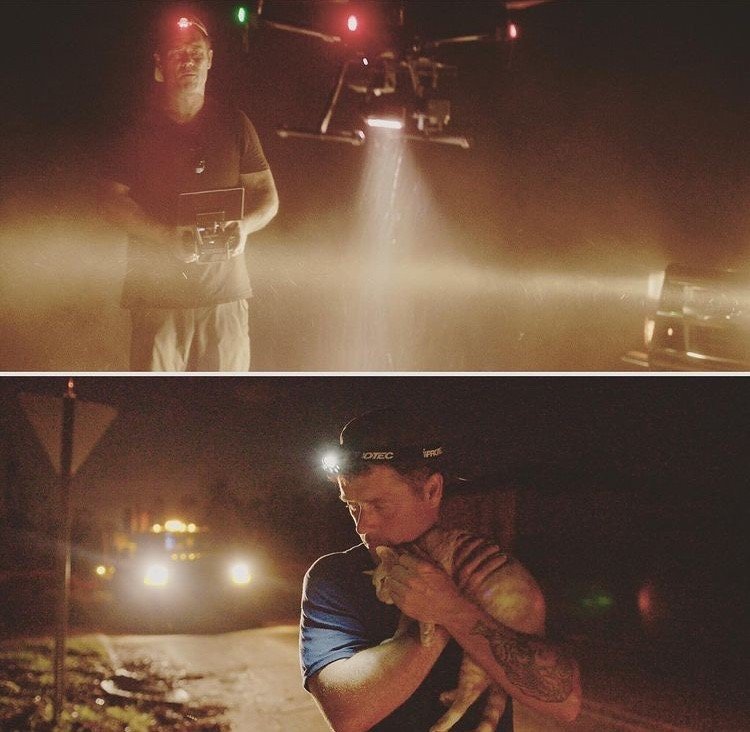
Matrice drone flies over scene of natural disaster (Photo courtesy Douglas Thron, used with permission.)
Drone Pilot and Photographer Douglas Thron travels the world following natural disasters, using drones for animal rescue.
By Jim Magill
Natural disasters – hurricanes, wildfires and tornados – leave a path of destruction in their wake, creating scores of victims, humans of course, but also animal victims.
Rescuing animals lost or stranded in the wake of disasters has become the life work of drone pilot and aerial photographer/cinematography Douglas Thron. Using a Matrice 210 V2 drone, outfitted with a FLIR XT2 camera, which integrates a high-resolution thermal sensor and a 4K visual camera, and a spotlight, Thron has found and rescued distressed animals in far-flung locals from Kentucky and Colorado to the Bahamas and Australia.
Thron’s rescues are chronicled in a TV show, “Doug to the Rescue,” produced by Curiosity Stream and available on HBO Max.
“I always had a love of animals,” Thron said in an interview. “As a kid growing up in Richardson Texas, outside of Dallas, I raised orphaned baby possums, squirrels, raccoons and beavers.”
While working as an aerial cinematographer, shooting footage from manned aircraft, such as Cessna planes and helicopters, he became an early adopter of drone technology.
“I saw someone had some footage from Phantom Ones in the early days of drones and I was just blown away by the footage,” he said. “I sold my experimental seaplane and bought one of those early Phantom drones and started doing aerial cinematography from that.”
In his work with shows including Nat Geo and Discovery, he encountered an animal rescuer who was using infrared scopes at night to locate and rescue animals impacted by natural disasters.
“I said, ‘Damn, I wonder if I could put one of these on a drone.’ Fast forward about eight months later, I was in the Bahamas after a hurricane and I was using drones to try to find dogs,” Thron recalled.
With his Matrice drone mounted with an infrared camera, Thron searched at night for dogs among the 30-foot-high piles of debris created by Hurricane Durian, a Category 5 storm that roared through the island nation in September 2019 with winds of up to 180 mph.
“In the beginning it was challenging because I was the first one doing this,” he said. “It was super challenging and frustrating because it would take hours and hours of getting the stuff to work and it would not work worth a damn. Now I’ve got it all working like a champ, all the bugs ironed out.”
One early difficulty he encountered centered on the sensitivity of the infrared camera equipment. The ground surface in the Bahamas retained a great deal of heat even at night, making it difficult to distinguish the dogs’ heat signatures from that of the surrounding environment. That situation improved when the XT2 camera came out, allowing him to switch from infrared to visual camera mode.
“But you’d still get false hot readings, from an ashcan lid or a burl in the side of a tree,” he said. Thron mounted a spotlight that would move simultaneously with the infrared camera, so he could switch the camera to visual mode and be able to see what was registering the heat signature, whether it was an animal in distress or just a rock on the ground.

Douglas Thron holds female baby koala, rescued in aftermath of Australia’s wildfires. (Photo courtesy Douglas Thron, used with permission.)
Drones for Animal Rescue: Saving baby koalas
In 2020, Thron traveled to Australia, which was being devastated by a series of massive wildfires, to help rescue koalas and other stranded animals. “The koalas were special,” he said. “I’d never seen a wild koala before.”
The big fires had burned an area the size of the state of Oklahoma, destroying thousands of acres of habitat. Thron and his team were able to rescue dozens of koalas, climbing burned-out trees and setting live traps at the base of trees to catch the distressed animals.
Since then, Thron has responded to numerous natural disasters in the U.S. including wildfires in Colorado and the recent series of tornados that devastated large swaths of Kentucky. A number of these rescues have proved to be dramatic and difficult.
Flying his drone over a hurricane-ravaged section of Louisiana in the weeks after a storm, Thron found a number of dogs chained up and left for dead.
“When you get to them, they’re starving. Sometimes, they’re lifeless. Other times they’re real defensive, just trying to bark. They’re probably hallucinating by that point, because, they’d not eaten for multiple weeks,” he said.
“If I hadn’t been out there flying with the drone, these animals would have been continually suffering, chained up to cars, or chained up to a little dog house.”
In another instance, Thron rescued a number of cats that had been badly burned in a fire. “I have the spotlight shining down and I have to go running after the animal, sometimes while simultaneously still flying the drone and hoping the drone battery lasts,” he said. “I’m not flying a drone with gloves on my hand, so I have to catch it bare-handed and grab whatever part of it that I can. They clawed and bit like hell.”
Another rescue involved freeing a pregnant dog that had been trapped under a pile of debris. “I was able get her free and she gave birth to nine puppies the following day.”

Douglas Thron uses his spotlight-equipped drone to help rescue cat. (Photos courtesy Douglas Thron, used with permission.)
Training future animal rescuers
Thron has a few words of caution for others who would like to follow in his footsteps and use drones for animal rescue. He recommended that would-be rescuers should first become proficient drone pilots, skilled in the use of their aerial vehicles and related equipment.
He said his work requires that he operate his Matrice in full manual mode. “Frequently, I have to drop down in between trees, into the canopy, hoping to keep the signal,” he said. “The one downside of the Matrice is of course the propellers are fixed. It’s not like a Mavic, where the propellers are flexible.” A collision with a tree branch can cause serious damage to the propellers and potential loss of the expensive drone.
He added that would-be animal rescuers should not expect to get rich from their efforts, at least not until a new rescue industry develops some years into the future.
“Because I do have a TV show, obviously I get paid,” he said. He recommended that certified drone pilots focus their efforts on more lucrative pursuits, and treat animal rescue as a strictly volunteer effort. “You’ve got to really be making money from filming. Real estate is obviously the best way to make money off of drones, or power line inspection,” he said.
As to using drones for animal rescue, “It’s definitely a labor of love,” he said.
Read more about drones doing good in the world: catching poachers, tracking trash, and helping communities rebuild after wildfires.
 Jim Magill is a Houston-based writer with almost a quarter-century of experience covering technical and economic developments in the oil and gas industry. After retiring in December 2019 as a senior editor with S&P Global Platts, Jim began writing about emerging technologies, such as artificial intelligence, robots and drones, and the ways in which they’re contributing to our society. In addition to DroneLife, Jim is a contributor to Forbes.com and his work has appeared in the Houston Chronicle, U.S. News & World Report, and Unmanned Systems, a publication of the Association for Unmanned Vehicle Systems International.
Jim Magill is a Houston-based writer with almost a quarter-century of experience covering technical and economic developments in the oil and gas industry. After retiring in December 2019 as a senior editor with S&P Global Platts, Jim began writing about emerging technologies, such as artificial intelligence, robots and drones, and the ways in which they’re contributing to our society. In addition to DroneLife, Jim is a contributor to Forbes.com and his work has appeared in the Houston Chronicle, U.S. News & World Report, and Unmanned Systems, a publication of the Association for Unmanned Vehicle Systems International.
Miriam McNabb is the Editor-in-Chief of DRONELIFE and CEO of JobForDrones, a professional drone services marketplace, and a fascinated observer of the emerging drone industry and the regulatory environment for drones. Miriam has penned over 3,000 articles focused on the commercial drone space and is an international speaker and recognized figure in the industry. Miriam has a degree from the University of Chicago and over 20 years of experience in high tech sales and marketing for new technologies.
For drone industry consulting or writing, Email Miriam.
TWITTER:@spaldingbarker
Subscribe to DroneLife here.
https://dronelife.com/2022/01/23/drones-for-animal-rescue-doug-thron/
 Unmanned Aerial Vehicle The latest drone news
Unmanned Aerial Vehicle The latest drone news



